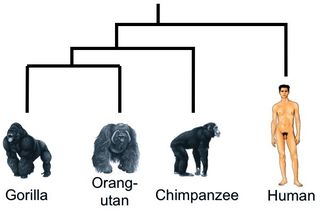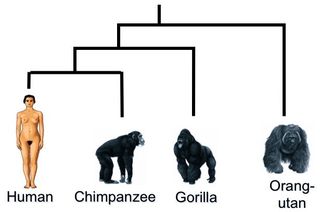Psychiatry
A New Science of Human Evolution—and Evolutionary Psychiatry
Genomics is revolutionizing evolution: physical, psychological, and psychiatric.
Posted September 29, 2016
Once upon a time, human evolution was almost exclusively concerned with fossils, prehistoric artifacts, and comparative anatomy. In other words, you had to rely on fossilized remains of pre-humans, their preserved tools or trappings, and comparisons of them with extinct or living apes and monkeys. What you concluded from it all was often controversial and open to abuse from many different angles—even fraud and forgery, as the notorious Piltdown Man scandal showed.

Where our place in evolution is concerned, the result was generally agreed to be as illustrated left: one which—contrary to Darwin's view—split humans off from the other apes at the earliest, remotest node, thereby distancing us as far away from our ape relatives as possible.
But things have changed, as a recently published book, Ancestors in Our Genome, makes unmistakably clear. Now human evolution can be studied in terms of comparative genomics, and a completely new, radically different picture is emerging. By comparison with the older approach, genetic evolutionary biology differs in three main ways.
First, the new science of human evolution is reductionistic, bottom-up, and based on DNA sequences, rather than being holistic, top-down and based on anatomical comparisons.
Secondly, the new approach is quantitative, statistical, and relies on numerical data, rather than being qualitative, singular, and indeed sometimes relying on solitary specimens: Entire extinct species have been proposed on the evidence of a single fossilized tooth!
Finally, the genetic approach can also be experimental rather than purely observational as the older anthropology tended to be. For example, a key human language gene, FOXP2, has been experimentally introduced into mice:
Young pups with the human gene, known as “humanized mice,” … were found to exhibit new and different vocalizations… In the “humanized mice,” … the FOXP2 gene causes extensive and significant changes in interacting parts of the brain that are involved in language. Thus experimental evidence strongly implicates FOXP2 as one gene that contributes to human language … (pp.106-7)

The result is that DNA evidence now provides an altogether different picture of human origins: one in which humans are as closely related to the apes as they can be in a cladogram based on genetic, rather than anatomical resemblances—just as Darwin would have predicted (left).
The difference between this and the earlier, un-Darwinian view could not be greater. And the new picture is of course the correct one. How could it be otherwise? Who would believe a paternity suit decided by judging appearances when a definitive DNA test was available? And if that is true of individual familial relationships, it has also to be true of relatedness between species.
Furthermore, there are lessons here for both evolutionary psychology and psychiatry. Where evolutionary psychology is concerned, it is obvious that what is true of our bodies and physical adaptations must also be true of our brains and mental ones, as FOXP2 shows. Genes may not be able to decide what language you speak, but they demonstrably determine whether you can speak it!
Like anthropologists of the past, psychiatrists have argued endlessly about mental illness, basing their arguments on observation, comparison, and case histories. Psychiatry largely lacked reductive explanations based on genetics and neuroscience, and in the past was seldom able to make predictions, let alone able to test them against huge statistical samples of the kind which have vindicated the imprinted brain theory.

Finally, the author I am quoting notes that FOXP2 “is actually a regulatory gene, meaning its protein influences the expression of an extensive network of genes,” just as many imprinted genes do. Another FOX gene suspected of being imprinted, FOXG1, is implicated in a further factor in human evolution—brain size—just as predicted by the imprinted brain theory's diametric model of mental illness (left) and as demonstrated by laboratory experiments with organoids.
The imprinted brain theory has been described as possibly being psychiatry’s “grandest working theory since Freud, and one that is founded in work at the forefront of science.” But The New York Times also noted that “The theory has no use for psychiatry’s many separate categories for disorders, and it would give genetic findings an entirely new dimension”—just as genome-based science has begun to do where anthropology is concerned.


